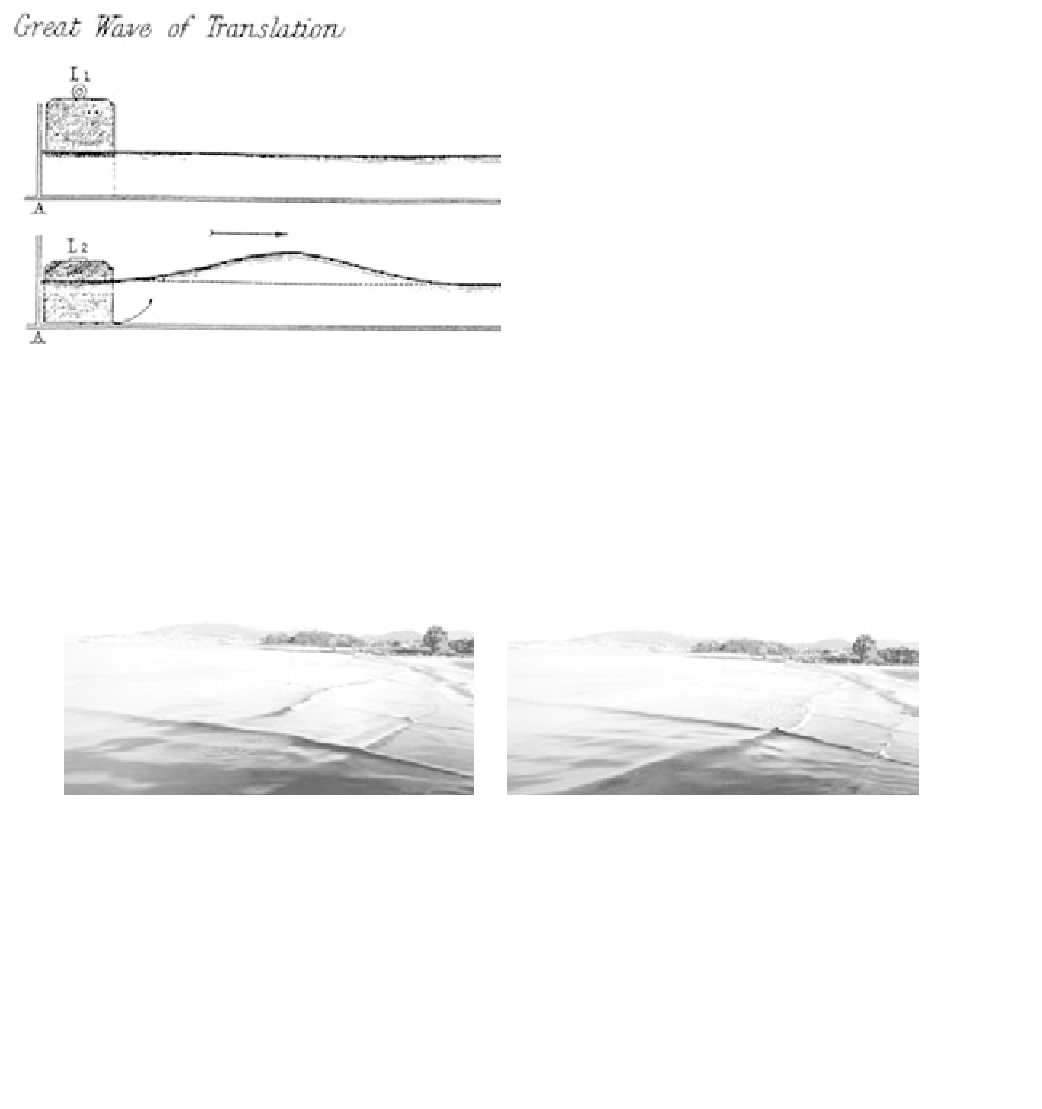Geoscience Reference
In-Depth Information
written in 1844:
Briefly, a solitary wave is equivalent to the top half of a
harmonic wave placed on top of undisturbed fluid, with all
the water in the waveform moving with the wave; such
bores, unlike surface oscillatory gravity waves, transfer
water mass in the direction of their propagation.
Somewhat paradoxically we can also speak of trains of soli-
tary waves within which individuals show
dispersion
due to
variations in wave amplitude. They propagate without
change of shape, any higher amplitude forms overtaking
lower forms with the very remarkable property, discovered
in the 1980s, that, after collision, the momentarily com-
bining waves separate again, emerging from the interaction
with no apparent visible change in either form or velocity
(Fig. 4.46). Such solitary waves are called
solitons
.
I happened to be engaged in observing the motion of a vessel at
a high velocity, when it was suddenly stopped, and a violent and
tumultuous agitation among the little undulations which the ves-
sel had formed around it attracted my notice. The water in vari-
ous masses was observed gathering in a heap of a well-defined
form around the centre of the length of the vessel. This accumu-
lated mass, raising at last to a pointed crest, began to rush for-
ward with considerable velocity towards the prow of the boat,
and then passed away before it altogether, and, retaining its form,
appeared to roll forward alone along the surface of the quiescent
fluid, a large, solitary, progressive wave. I immediately left the
vessel, and attempted to follow this wave on foot, but finding its
motion too rapid, I got instantly on horseback and overtook it in
a few minutes, when I found it pursuing its solitary path with a
uniform velocity along the surface of the fluid. After having fol-
lowed it for more than a mile, I found it subside gradually, until
at length it was lost among the windings of the channel.
4.9.5
Internal fluid waves
Within the oceans there exist sharply-defined sublayers of
the water column which may differ in density by only small
amounts (Fig. 4.47). These density differences are com-
monly due to surface warming or cooling by heat energy
transfer to and from the atmosphere by conduction. They
may also be due to differences in salinity as evaporation
occurs or as freshwater jets mix with the ambient ocean
mass. The density contrast between layers is now small
enough (in the range 3-20 kg m
3
, or 0.003-0.02) so that
the less dense and hence buoyant surface layers feel the
drastic effects of reduced gravity. Any imposed force caus-
ing a displacement and potential energy change across the
sharp interface between the fluids below the surface is now
opposed by a
reduced gravity
(Section 3.6) restoring f
orc
e,
g
)
g
. The wave propagation speed, is
now r
edu
ced in proportion to this reduced gravity, to
, while the wave height can be very much larger.
Internal waves of long period and high amplitude progres-
sively “leak” their energy to smaller length scales in an
energy
“
cascade
,” causing turbulent shear that may
(
/
c
gh
Fig. 4.45
Solitary waves: Russell's original sketch to illustrate the
formation and propagation of a solitary wave. You can achieve the
same effect with a simple paddle in a channel, tank, or bath. The
solitary wave is raised as a “hump” of water above the general
ambient level. The “hump” is thus transported as the excess mass
above this level, as well as by the kinetic energy it contains by virtue
of its forward velocity,
c
.
g
h
c
Solitons in shallow water
t
= 0
t
= +1 s
B
A
B
A
C
B
A
B
A
C
Fig. 4.46
Solitary wave A-A
has just formed as a reflected wave from a harbor wall behind and to the left. The views show the wave moving
forward (
c
1 m s
1
) through incoming shallow water waves B-B
and C-C
with little deformation or diminution.











Search WWH ::

Custom Search